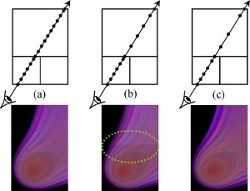Abstract

Multi-resolution techniques are required for rendering large volumetric datasets exceeding the size of the graphics cards memory or even the main memory. The cut through the multi-resolution volume representation is defined by selection criteria based on error metrics. For GPU-based volume rendering, this cut has to fit into the graphics cards memory and needs to be continuously updated due to the interaction with the volume such as changing the area of interest, the transfer function or the viewpoint. We introduce a greedy cut update algorithm based on split-and-collapse operations for updating the cut on a frame-to-frame basis. This approach is guided by a global data-based metric based on the distortion of classified voxel data, and it takes into account a limited download budget for transferring data from main memory into the graphics card to avoid large frame rate variations. Our out-of-core support for handling very large volumes also makes use of split-and-collapse operations to generate an extended cut in the main memory. Finally, we introduce an optimal polynomial-time cut update algorithm, which maximizes the error reduction between consecutive frames. This algorithm is used to verify how close to the optimum our greedy split-and-collapse algorithm performs.
